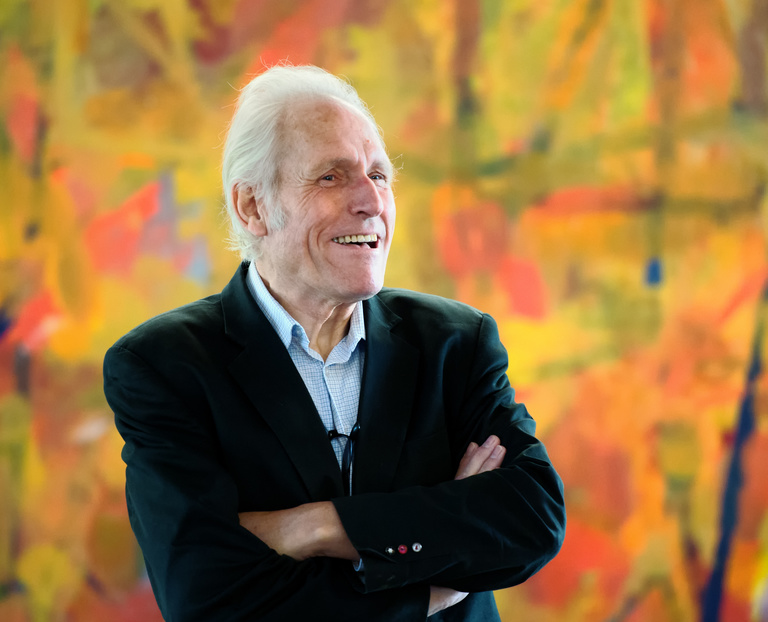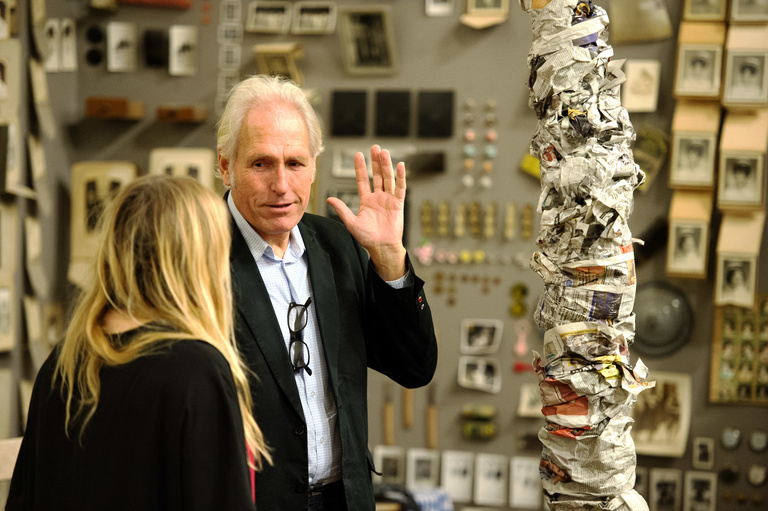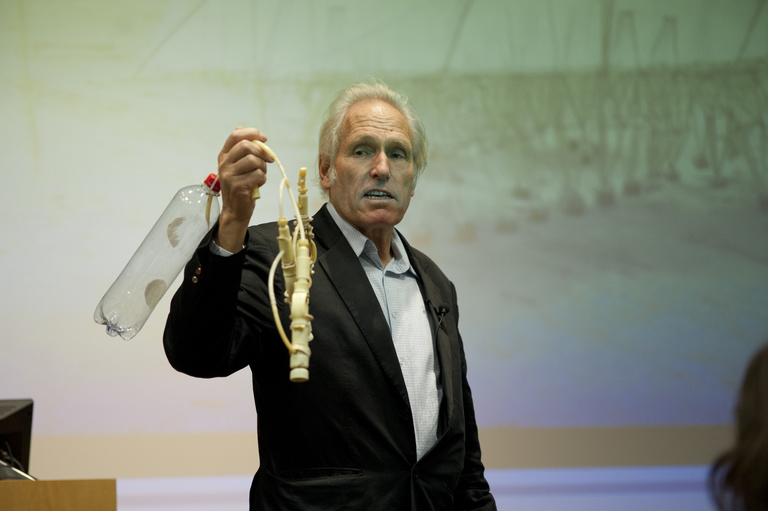
“I like to balance between reality and imagination,” Theo Jansen said Tuesday morning during the breakfast reception of his visit to the University of Iowa. “We have to dream our lives and not just exist.”
Jansen came as part of the Creative Matters lecture series sponsored by the Office of Research and Economic Development, seeking to demonstrate that creativity is not only at the core of research and discovery, but is also central to our human experience.
His own life’s work is a pinnacle of this philosophy. Called a kinetic sculptor, an engineer, a landscape artist, Jansen has spent 25 years creating his Strandbeest—animals made of plastic tubes and sails, which walk on their own across the beaches of his home in the Netherlands.
The Strandbeest came into conception in 1990 when Jansen wrote a newspaper column about skeletons that could build dunes on the beaches to protect the Netherlands from predicted rising sea levels. Then one day, he passed a tool shop and saw the PVC pipes that became his building blocks. He bought some and spent an afternoon experimenting with them.
“I decided to spend one year with them, and then it got out of hand,” Jansen said.
His first creature could only move its legs when lying on its back. Now, his animals walk on their own, powered by the wind, and even respond to their environment. If a storm is coming, the creature might hammer a peg into the sand to avoid being blown away. A more recent version throws sand onto a plate to act as an anchor.
Jansen talks about the evolution of the Strandbeest. Traits that work are carried on to the next generation, while the less effective die out. Throughout his work, he has been fascinated with evolutionary theory, and particularly Richard Dawkins’ book The Blind Watchmaker.
The Strandbeest are divided into time periods like geological eras and given names, such as Animaris Percipiere and Animaris Currens Vulgaris. When Jansen is finished with one creature, he refers to it as being extinct. These used to lie in a large boneyard, but now they go into museum exhibitions. He says when see them, you are seeing their fossils.
Despite this elaborate story of a new nature, Jansen remains down-to-earth about the Strandbeest. His love for them is a love for mathematics, a love for physics; it’s very different from a love for a person, he says.
“People have the feeling they are alive because of their legs,” he says. “Our eyes are very sensitive for the movement of legs.”
When people look at the Strandbeest, they feel like they are seeing a living creature, but really they are seeing just a bunch of tubes.
Yet, this possibility of blurring reality and fantasy is a large part of what motivates Jansen. In 1980, Jansen created a flying saucer which he flew across his city of Delft. Four meters wide and lifted by helium, the saucer alarmed many people. On the hazy day, all they saw was a black disc against the sky, with no depth to estimate its height or size. Much like after the broadcast of Orwell’s War of the Worlds, people panicked.
Jansen said he enjoyed the fame that came when people found out the flying saucer was his work, but his true love for creating seems to come from this blurred sense of reality.
Jansen asserts that, “We make our own reality in our brain—we dream our reality.”
In his dream, he is the creator of a new form of life, working solely with PVC pipes, which he compares to an original creator making life on earth made up only of proteins. He believes limiting himself to the pipes has fostered his creativity.
While touring Studio Arts, Jansen spoke with an art student using material from the farm where she grew up—corn, cattle bones, and old pictures were spread on the walls and table of her space. In the middle stood an unfinished tower made out of newspaper.
Jansen told her the material artists use is often more creative than themselves.
“Our brains are very similar,” he said. “What I have been thinking of, you might have been thinking of as well. But if you follow the material, you are sure to get someplace no one has been before.”

At his lecture in Pomerantz Center on Tuesday night, 400 people showed up. Some arrived over an hour early. Jansen brought small versions of the Strandbeest in his suitcase and demonstrated how they worked, opening the floor for audience questions at the end. A young girl asked Jansen why he makes the Strandbeest.
Jansen said there is no reason—but that’s nothing unusual. There is no reason for our own existence, he said. It’s not good for anything in particular, and yet he sees it as a great miracle that we are here.
His Strandbeest somehow echo that philosophy. He has said that he wants to set them out in herds on beaches, so they will live their own lives. Privately, he admits this is a bit of a utopian dream, but something about it is nonetheless appealing and true for him.
“You could see it as a fairytale, but some fairytales have very strong roots in reality,” he said.
The Strandbeest, walking whimsically across Netherland beaches, have no clear purpose. Jansen does not even have an answer for whether he considers them a work of engineering or art. They simply are, and he is driven to create them again and again.
“People call me an artist, but I don’t know what I am,” Jansen says. “When I am on the beach, under the clouds and the rain, I feel like I am not living in this time. All these questions of whether I am an artist or an engineer seem irrelevant.”

Jansen’s Strandbeest will be on exhibition at the Chicago Cultural Center next year, from February 6 to May 1. For more information, visit http://www.choosechicago.com/event/Strandbeest-The-Dream-Machines-of-Theo-Jansen/28010/?micrositeid=110.
The Creative Matters lecture series seeks to demonstrate that creativity is not only at the core of all research and discovery, but is also central to our human experience. The lineup of invited speakers includes artists, thinkers, builders, and doers who challenge conventional thinking about creativity, science, and artistic expression, borrowing from a range of influences and disciplines in their work.
The Office of the Vice President for Research and Economic Development provides resources and support to researchers and scholars at the University of Iowa and to businesses across Iowa with the goal of forging new frontiers of discovery and innovation and promoting a culture of creativity that benefits the campus, the state, and the world. More at http://research.uiowa.edu, and on Twitter: @DaretoDiscover.